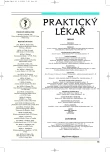The long pentraxin PTX3 – a new acute phase reactant
Authors:
P. Kuneš 1; J. Krejsek 2
Authors‘ workplace:
Kardiochirurgická klinika LF UK a FN Hradec Králové, přednosta doc. MUDr. J. Harrer, CSc.
1; Ustav klinické imunologie a alergologie LF UKa FN Hradec Králové, přednosta MUDr. Otakar Kopecký, CSc.
2
Published in:
Prakt. Lék. 2006; 86(2): 71-77
Category:
Various Specialization
Overview
Pentraxin 3 is a novel protein of the acute phase response which shares a striking degree of homology with the well-known pentraxin C-reactive protein. Whereas CRP is made up in the liver and its effects are disseminated systemically to the whole body, PTX3 is produced directly within the inflammatory focus and its effects are targeted to the inflamed tissue. Both pentraxins share the ability to activate complement via the classical pathway. Both PTX3 and CRP take part in the pathogenesis of some inflammatory diseases featuring an autoimmune component. In this respect, atherosclerosis including its complications represents a pathological condition that evokes much interest nowadays. This review article presents recently discovered effects of PTX3 in the pathogenesis of rheumatoid arthritis, the IgA nephropathy and atherosclerosis, with special emphasis being laid on the prognostic value of PTX3 in patients suffering from acute myocardial infarction, septic shock and pulmonary form of tuberculosis.
Key words:
pentraxin 3 – C-reactive protein – macrophages – endothelial cells – inflammatory response.
Labels
General practitioner for children and adolescents General practitioner for adultsArticle was published in
General Practitioner

2006 Issue 2
Most read in this issue
- Group B Streptococcus infection, screening, treatment - recommendation
- IgA nephropathy – the most common primary glomerulonephritis worldwide
- Ergomentry under physical load
- The long pentraxin PTX3 – a new acute phase reactant
